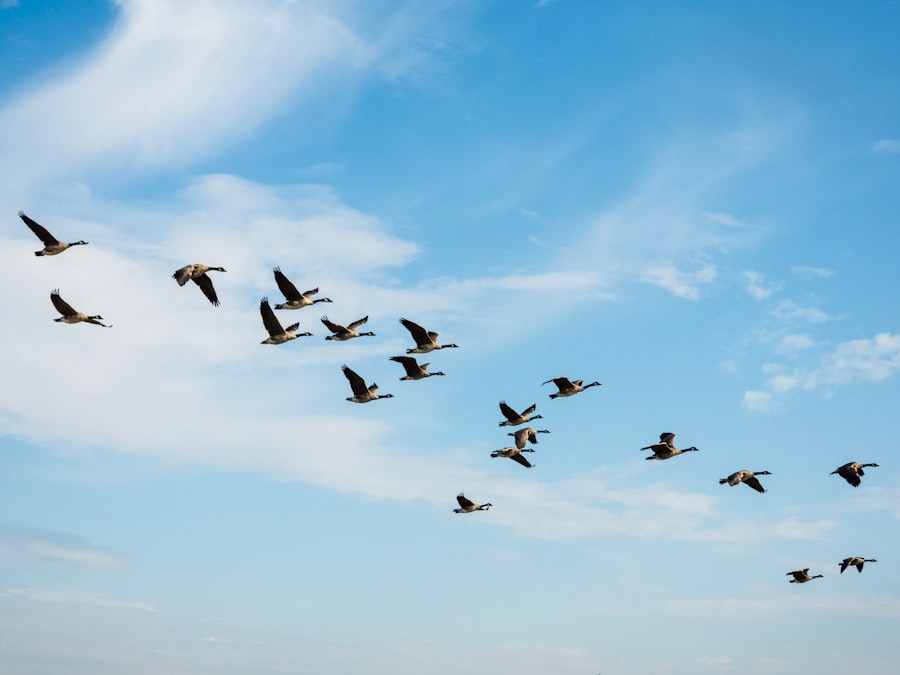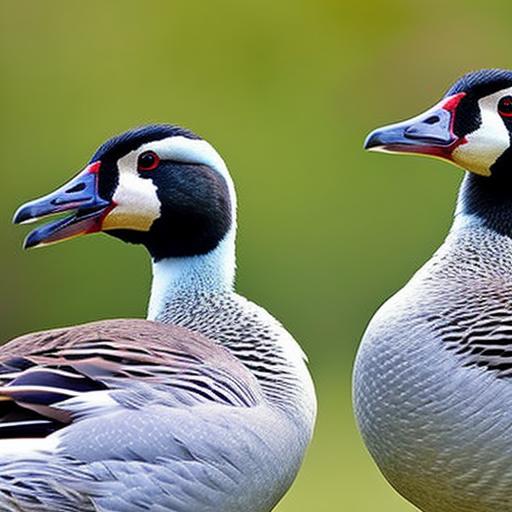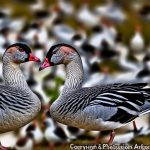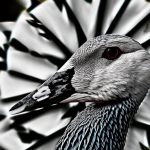Geese are often overlooked as potential pets, but they can make wonderful companions for those who are willing to understand and meet their basic needs. These intelligent and social birds require specific care and attention to thrive in a domestic setting. It is important for potential goose owners to educate themselves on the proper care and maintenance of these animals to ensure their well-being.
Key Takeaways
- Geese have basic needs for food, water, shelter, and safety.
- Providing a suitable habitat for geese involves creating a secure and comfortable living space.
- Feeding and watering geese requires a balanced diet and access to clean water.
- Maintaining cleanliness in the living space is essential for preventing disease and promoting good health.
- Proper health care for geese includes regular check-ups, vaccinations, and treatment for any illnesses or injuries.
Understanding the Basic Needs of Geese
A. Food and water requirements
Geese have specific dietary needs that must be met in order for them to remain healthy. They require a balanced diet consisting of grains, grass, and fresh vegetables. It is important to provide them with a variety of foods to ensure they receive all the necessary nutrients. Additionally, geese need access to clean and fresh water at all times.
B. Shelter and space needs
Geese require a suitable shelter that protects them from the elements and provides them with a safe place to rest and sleep. The shelter should be spacious enough to allow the geese to move around comfortably and should have proper ventilation to prevent the buildup of moisture and ammonia. Geese also need ample space to roam and graze, so it is important to provide them with a large outdoor area.
C. Socialization and companionship
Geese are highly social animals that thrive in the company of others. They form strong bonds with their flock mates and can become stressed or lonely if kept alone. It is important to provide geese with companionship by keeping them in a small flock or introducing them to other compatible birds.
Providing the Ideal Habitat for Geese
A. Choosing the right location
When setting up a habitat for geese, it is important to choose a location that is safe, secure, and suitable for their needs. The area should be free from potential hazards such as predators or toxic plants. It should also have access to fresh water sources such as ponds or streams.
B. Building a suitable shelter
The shelter for geese should be sturdy and well-insulated to protect them from extreme weather conditions. It should have proper ventilation to prevent the buildup of moisture and ammonia. The shelter should also have enough space to accommodate the entire flock comfortably.
C. Creating a safe and secure environment
To ensure the safety of the geese, it is important to create a secure environment that prevents them from escaping or being attacked by predators. This can be achieved by installing fencing around the perimeter of the habitat and using predator-proof materials for the shelter.
Feeding and Watering Your Geese
A. Choosing the right feed
Geese require a balanced diet that consists of grains, grass, and fresh vegetables. It is important to choose high-quality feed that is specifically formulated for geese. This will ensure that they receive all the necessary nutrients for their overall health and well-being.
B. Providing clean and fresh water
Geese need access to clean and fresh water at all times. It is important to provide them with a water source that is large enough for them to submerge their heads in, as they use this behavior to clean their eyes and nostrils.
C. Feeding schedule and quantity
Geese should be fed twice a day, once in the morning and once in the evening. The amount of feed given should be based on their age, size, and activity level. It is important not to overfeed geese, as this can lead to obesity and other health issues.
Maintaining Cleanliness in Your Geese’s Living Space
A. Regular cleaning and disinfecting
To maintain cleanliness in your geese’s living space, it is important to regularly clean and disinfect their shelter and surrounding areas. This will help prevent the buildup of bacteria and parasites that can cause diseases.
B. Proper waste management
Geese produce a significant amount of waste, so it is important to have a proper waste management system in place. This can include using absorbent bedding materials, regularly removing and disposing of waste, and composting or disposing of waste in an environmentally friendly manner.
C. Preventing the spread of diseases
To prevent the spread of diseases, it is important to practice good biosecurity measures. This includes quarantining new birds before introducing them to the flock, regularly monitoring the health of the geese, and practicing proper hygiene when handling them.
Ensuring Proper Health Care for Your Geese

A. Regular check-ups with a veterinarian
Regular check-ups with a veterinarian are essential for maintaining the health and well-being of your geese. A veterinarian can provide vaccinations, deworming treatments, and general health assessments to ensure that your geese are in optimal condition.
B. Vaccinations and deworming
Geese should receive vaccinations to protect them against common diseases such as avian influenza and Newcastle disease. They should also be regularly dewormed to prevent infestations of internal parasites.
C. Identifying and treating common health issues
It is important to be able to identify common health issues in geese and take appropriate action. This can include recognizing signs of respiratory infections, foot problems, or nutritional deficiencies. Prompt treatment can help prevent further complications and ensure a speedy recovery.
Protecting Your Geese from Predators
A. Identifying potential predators
Geese are vulnerable to a variety of predators, including foxes, raccoons, and birds of prey. It is important to be able to identify potential predators in your area and take appropriate measures to protect your geese.
B. Building a predator-proof enclosure
To protect your geese from predators, it is important to build a predator-proof enclosure. This can include using sturdy fencing materials, installing secure locks on doors and windows, and using deterrents such as motion-activated lights or alarms.
C. Using deterrents and traps
In addition to building a predator-proof enclosure, it may be necessary to use deterrents and traps to keep predators away from your geese. This can include using scarecrows, noise-making devices, or live traps to capture and relocate predators.
Training Your Geese to Behave Properly
A. Establishing trust and respect
Training geese requires establishing trust and respect between the owner and the birds. This can be achieved through positive reinforcement techniques such as rewards and praise.
B. Teaching basic commands
Geese can be trained to respond to basic commands such as “come,” “stay,” and “no.” This can help keep them safe and prevent them from engaging in unwanted behaviors.
C. Correcting bad behavior
When geese engage in unwanted behaviors, it is important to correct them in a firm but gentle manner. This can include redirecting their attention, using verbal cues, or withholding rewards until the behavior improves.
Building a Strong Bond with Your Geese
A. Spending quality time with your geese
Building a strong bond with your geese requires spending quality time with them on a regular basis. This can include interacting with them, providing them with attention and affection, and participating in activities together.
B. Understanding their personalities
Each goose has its own unique personality, so it is important to understand and respect their individual traits. This can help strengthen the bond between you and your geese and ensure a positive and nurturing environment.
C. Creating a positive and nurturing environment
To build a strong bond with your geese, it is important to create a positive and nurturing environment for them. This can include providing them with a comfortable living space, offering them plenty of mental stimulation, and ensuring that their physical and emotional needs are met.
Creating a Safe and Enjoyable Environment for Your Geese
A. Providing toys and activities
Geese are intelligent animals that require mental stimulation to prevent boredom and destructive behaviors. Providing them with toys and activities such as puzzles, mirrors, or floating objects in their water can help keep them entertained.
B. Encouraging exercise and exploration
Geese need regular exercise to maintain their physical health and well-being. Providing them with ample space to roam and graze, as well as encouraging them to explore their surroundings, can help keep them active and engaged.
C. Creating a comfortable and stimulating living space
To ensure that your geese are comfortable and stimulated, it is important to provide them with a suitable living space. This can include providing them with soft bedding materials, perches or platforms for resting, and access to natural elements such as grass or water.
Dealing with Common Problems Encountered in Keeping Geese
A. Aggression towards humans or other animals
Geese can sometimes exhibit aggressive behavior towards humans or other animals. This can be addressed by establishing boundaries, using positive reinforcement techniques, and seeking professional help if necessary.
B. Egg-laying issues
Female geese may experience issues with egg-laying, such as egg binding or excessive egg production. It is important to monitor their reproductive health and seek veterinary assistance if any issues arise.
C. Molting and feather loss
Geese undergo an annual molt where they shed their old feathers and grow new ones. During this time, they may experience feather loss and appear less attractive. It is important to provide them with proper nutrition and care during this period to support healthy feather growth.
Keeping geese as pets can be a rewarding experience for those who are willing to understand and meet their basic needs. By providing the ideal habitat, feeding and watering them properly, maintaining cleanliness in their living space, ensuring proper health care, protecting them from predators, training them to behave properly, building a strong bond, creating a safe and enjoyable environment, and addressing common problems, geese can thrive in a domestic setting. With the right knowledge and commitment, geese can make wonderful companions and bring joy to their owners’ lives.
If you’re interested in learning more about how to keep geese, you might also find this article on chicken coop designs helpful. It provides valuable insights into creating a secure and predator-proof environment for your poultry. Check out the article here for tips and ideas on building a sturdy chicken coop in Chester, SC.
FAQs
What are some reasons to keep geese?
Geese can be kept for various reasons, including as pets, for meat, for eggs, for weed control, and for their feathers.
What are some common breeds of geese?
Some common breeds of geese include Toulouse, Embden, African, Chinese, and Canada geese.
What kind of housing do geese need?
Geese need a shelter that is dry, draft-free, and well-ventilated. The shelter should be large enough to accommodate all the geese comfortably and should have a nesting area for egg-laying.
What do geese eat?
Geese are herbivores and primarily eat grass, weeds, and other vegetation. They can also be fed commercial poultry feed and supplements.
How do you keep geese safe from predators?
Geese can be kept safe from predators by providing them with a secure shelter at night, fencing off their grazing area, and using guard animals such as dogs or llamas.
How often do geese need to be fed?
Geese should be fed twice a day, once in the morning and once in the evening. They should have access to fresh water at all times.
How do you train geese?
Geese can be trained using positive reinforcement techniques such as treats and praise. They can be taught to come when called, to follow a leader, and to perform simple tricks.
Meet Walter, the feathered-friend fanatic of Florida! Nestled in the sunshine state, Walter struts through life with his feathered companions, clucking his way to happiness. With a coop that’s fancier than a five-star hotel, he’s the Don Juan of the chicken world. When he’s not teaching his hens to do the cha-cha, you’ll find him in a heated debate with his prized rooster, Sir Clucks-a-Lot. Walter’s poultry passion is no yolk; he’s the sunny-side-up guy you never knew you needed in your flock of friends!







